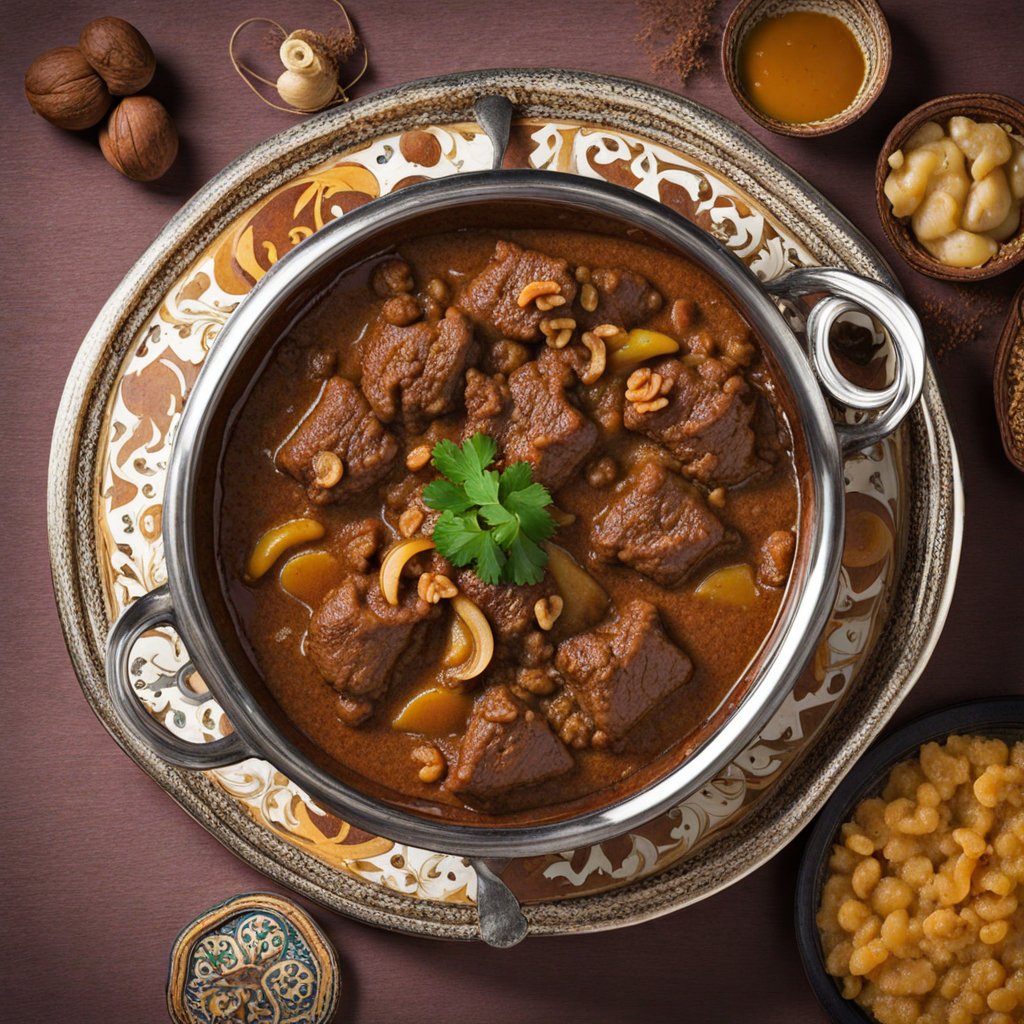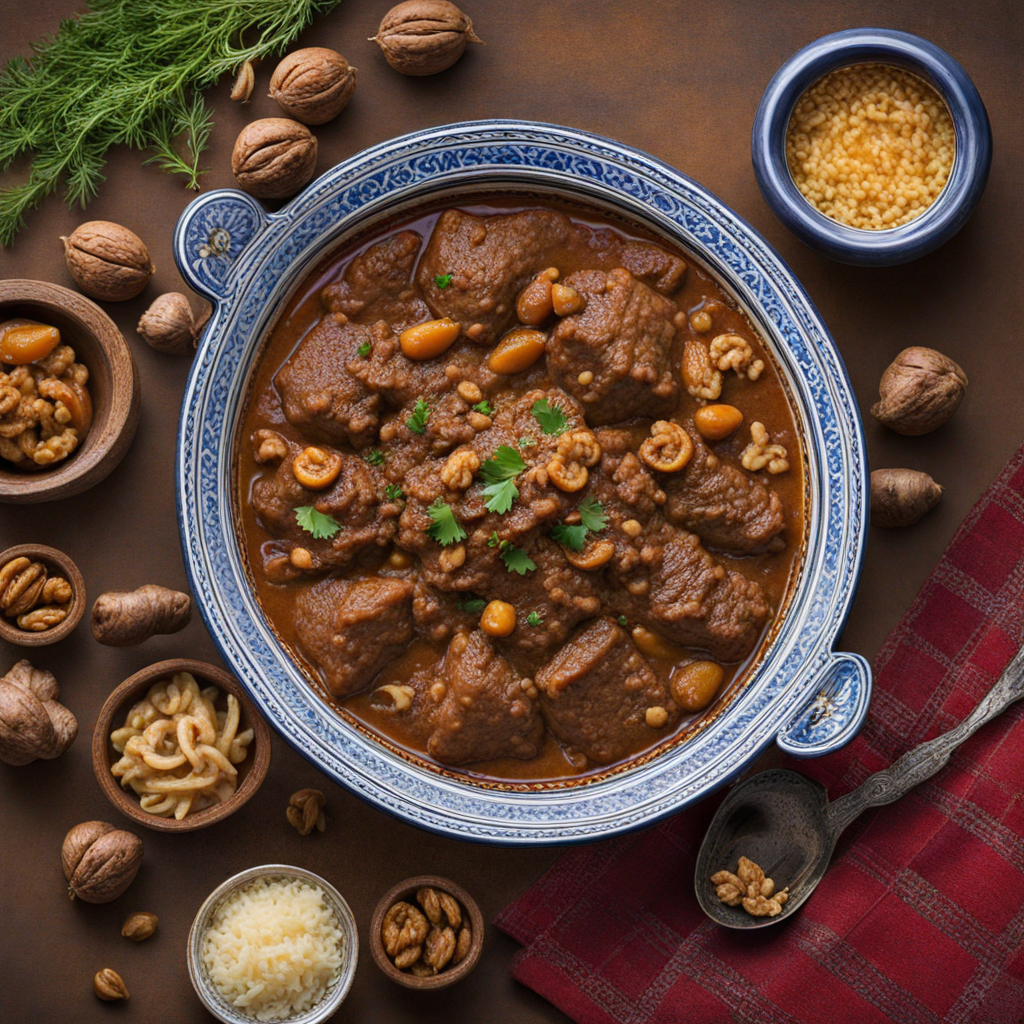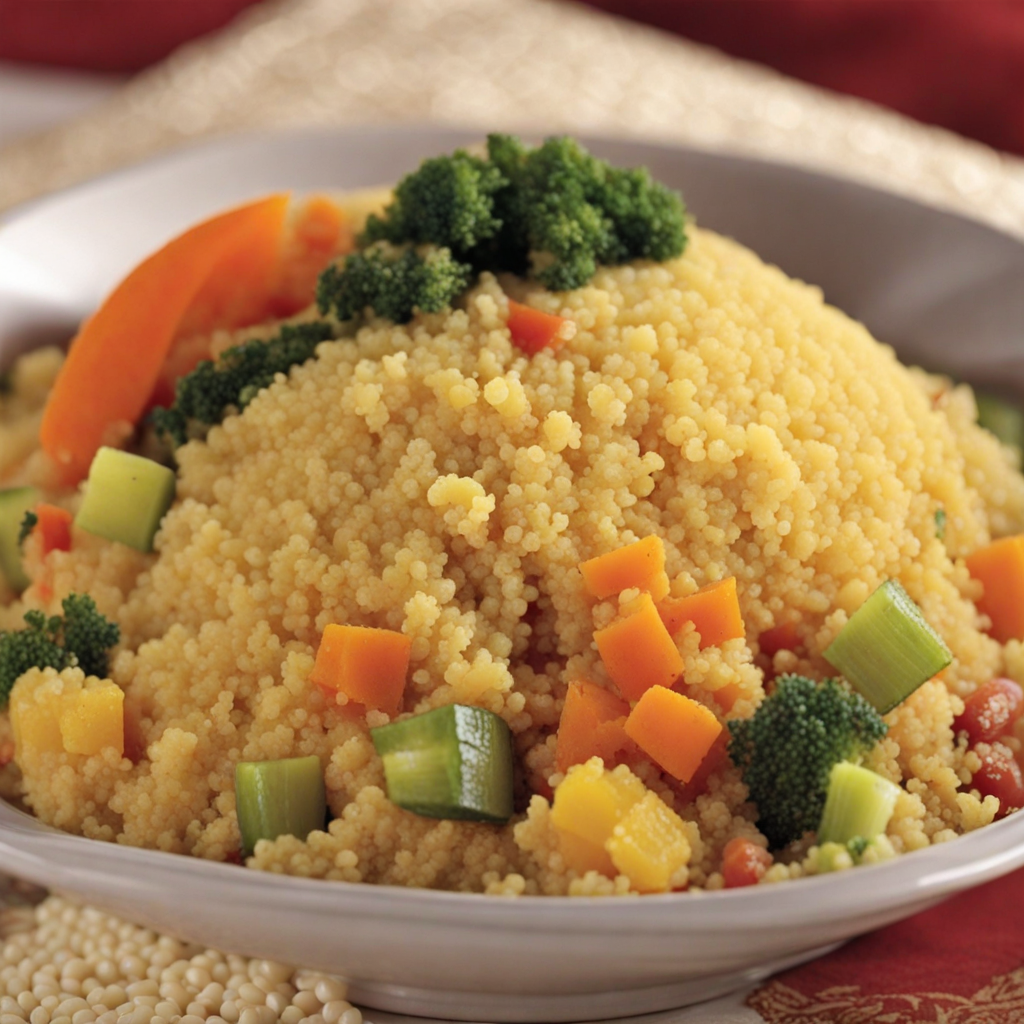Beef and Walnut Tagine
Beef and Walnut Tagine is a rich and aromatic dish that beautifully showcases the vibrant flavors of Moroccan cuisine. At its core, this tagine features tender chunks of beef that are slowly braised to perfection, allowing the meat to absorb the complex spices that make Moroccan food so distinctive. A delightful combination of spices like cumin, coriander, cinnamon, and ginger creates a warm and inviting aroma that envelops the dish. The slow cooking process in a traditional clay pot, known as a tagine, ensures that the beef remains succulent and infused with the spices, while the moisture from the ingredients helps to create a luscious sauce. Adding to the dish's allure, walnuts provide a delightful crunch and a nutty flavor that complements the hearty beef. These nuts are often toasted to enhance their natural oils and deepen their flavor before being incorporated into the tagine. The combination of beef and walnuts creates a satisfying texture contrast, making each bite a delightful experience. Dried fruits, such as apricots or prunes, are commonly included, adding a touch of sweetness that balances the savory elements of the dish, further enhancing its depth and complexity. Served alongside fluffy couscous or warm crusty bread, Beef and Walnut Tagine is perfect for soaking up the delectable sauce. This dish not only offers a unique taste experience but also reflects the rich cultural heritage of Morocco, where meals are often shared and enjoyed in a communal setting. Each bite transports you to the vibrant markets and lively streets of Moroccan towns, making it a perfect choice for those eager to explore new flavors and culinary traditions.
How It Became This Dish
The History of طاجين اللحم بالجوز (Tajine of Meat with Walnuts) from Morocco Food is an integral part of culture, and Moroccan cuisine is a vibrant tapestry woven from a rich history of trade, migration, and cultural exchange. Among the many dishes that epitomize this culinary heritage is طاجين اللحم بالجوز (Tajine of Meat with Walnuts). This dish not only showcases the flavors and ingredients typical of Moroccan cooking but also encapsulates the historical influences that have shaped the nation’s culinary landscape. Origins The tajine, a traditional Moroccan cooking vessel, has been central to Moroccan life for centuries. The word "tajine" refers both to the earthenware pot and the food cooked within it. The origins of the tajine can be traced back to the Berber people, the indigenous inhabitants of North Africa. The Berbers have long used clay pots for cooking over an open fire, and this cooking method helps to preserve the moisture and flavors of the ingredients. The use of meat, particularly lamb or beef, in Moroccan tajines can be linked to the region's pastoral traditions. The availability of livestock, influenced by the country's varied geography and climate, made meat a staple in the diet of many Moroccans. The addition of walnuts to the dish is particularly interesting, as walnuts are not native to Morocco. They were introduced via trade routes, likely through interactions with Mediterranean and Middle Eastern cultures, reflecting the global exchanges that have been a hallmark of Moroccan history. Cultural Significance Tajine of Meat with Walnuts is more than just a dish; it embodies hospitality, community, and tradition in Moroccan culture. In Morocco, sharing a meal is a communal activity that fosters relationships and strengthens bonds among family and friends. The tajine is often served at gatherings, celebrations, and family meals, where it is placed at the center of the table, allowing everyone to partake from the same dish. The dish also reflects the importance of seasonal ingredients and the art of balancing flavors. The combination of tender meat, rich spices, and the crunch of walnuts creates a dish that is both hearty and refined. Spices such as cinnamon, cumin, and saffron are commonly used in Moroccan cooking, and they add depth and warmth to the tajine. The use of nuts, particularly walnuts, also speaks to the significance of incorporating diverse textures and flavors in Moroccan cuisine. Development Over Time As Morocco navigated through various historical epochs, the culinary landscape evolved significantly. The arrival of Arab conquerors in the 7th century brought with it new spices, cooking methods, and agricultural practices. The introduction of saffron, coriander, and other spices profoundly impacted Moroccan cooking, and these ingredients became staples in dishes like the Tajine of Meat with Walnuts. The medieval period saw the flourishing of Moroccan cities such as Fes and Marrakech, which became cultural and economic hubs. The mingling of different cultures—Berber, Arab, Jewish, and later European—enriched Moroccan cuisine. Each group contributed its unique flavors and culinary techniques, resulting in a vibrant and diverse food culture. The Jewish community, in particular, played an important role in Moroccan gastronomy, introducing new dishes and methods of preparation. The French protectorate in the early 20th century marked another significant chapter in Moroccan culinary history. French influence led to the introduction of new ingredients and cooking styles, but it also reinforced the distinctiveness of Moroccan cuisine. Traditional dishes like the Tajine of Meat with Walnuts remained deeply rooted in local customs, while simultaneously adapting to the changing food landscape. In contemporary Morocco, the tajine continues to be a symbol of national identity. The dish has transcended social classes and is enjoyed by people from all walks of life. Street vendors, home cooks, and high-end restaurants alike serve variations of tajines, each reflecting regional ingredients and personal interpretations. The Tajine of Meat with Walnuts, for instance, may vary in its preparation from one household to another, with some opting for the addition of dried fruits like apricots or prunes, while others might emphasize the nutty flavor of walnuts. Modern Interpretations In recent years, as Moroccan cuisine has gained international recognition, the Tajine of Meat with Walnuts has found its way onto menus in restaurants around the world. Chefs are experimenting with the traditional recipe, using alternative meats such as chicken or even plant-based proteins to cater to contemporary dietary preferences. The dish is often presented with a modern twist, showcasing the culinary creativity of chefs while honoring its traditional roots. Moreover, the global interest in Moroccan food has spurred culinary tourism, with many travelers seeking authentic experiences. Cooking classes and food tours featuring tajine preparation have become popular, allowing visitors to engage with the culture and traditions surrounding Moroccan cuisine. The tajine has also become a symbol of Moroccan hospitality, with many travelers sharing their experiences of enjoying a home-cooked tajine in a local family’s home, further solidifying its place in the global culinary scene. Conclusion The Tajine of Meat with Walnuts is a dish steeped in history, culture, and tradition. Its origins in Berber cooking, coupled with the influences of various cultures that have traversed Morocco over the centuries, have shaped it into the beloved dish it is today. As it continues to evolve and adapt, the tajine remains a symbol of Moroccan hospitality and a celebration of the rich tapestry of flavors that define this remarkable cuisine. Through every bite, one can taste the history, diversity, and warmth of Morocco—a country where food is not just sustenance but a way of life.
You may like
Discover local flavors from Morocco







